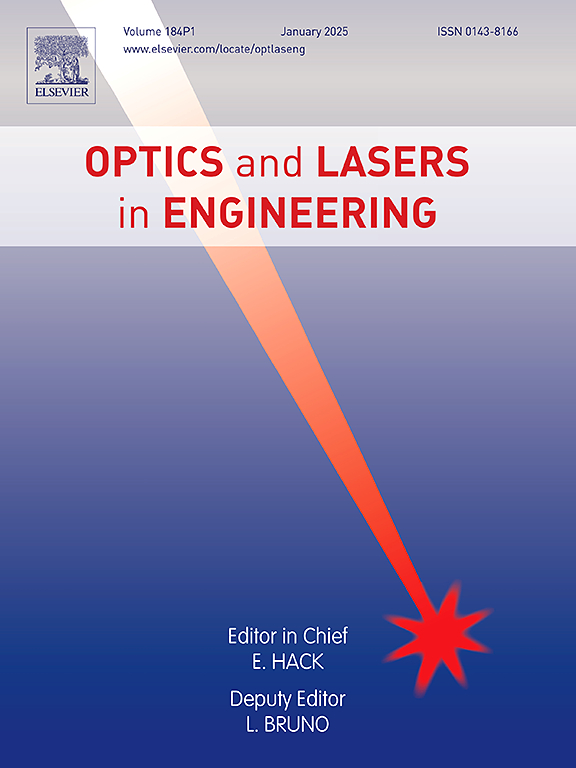Novel rotational speed measuring method based on micro-indentation-shaft detected by optical coherent system
IF 3.5
2区 工程技术
Q2 OPTICS
引用次数: 0
Abstract
Accurate rotational speed measurement is a prerequisite for realizing the condition monitoring and fault diagnosis of rotating equipment. This study proposes a novel rotational speed measurement method based on optical coherent displacement measurement. An optical coherence system is used to measure the relative depth of the shaft surface with uniformly etched micro-indentations on the circumferential surface. Fast Fourier transform (FFT) and the Hanning window energy centrobaric method (HnWECM) are used to process the collected photoelectric signals to obtain depth information and thereby realize the measurement of surface micro-indentations. During the operation, the rotational speed of the shaft is obtained by calculating the ratio of the angular difference between the relative depth of the rectangular pulses of the surface and the time interval. The experimental validation of the response is performed. The experimental results show that in the range of 0 rpm to 60 rpm, the indication error is <1 %, the nonlinearity error is <0.3584 %, and the repeatability error is <0.28 %. In the range of 0 rpm to 600 rpm, the rotational speed measurement method performed well with an indication error of <0.5 %, a maximum nonlinear error of 0.22 %, and a repeatability error of no >0.28 %. Compared with the results reported in existing literature, the proposed method offers advantages in terms of accuracy, linearity, and repeatability.
基于光学相干系统检测微压痕轴的新型转速测量方法
精确的转速测量是实现旋转设备状态监测和故障诊断的先决条件。本研究提出了一种基于光学相干位移测量的新型转速测量方法。利用光学相干系统测量轴表面的相对深度,并在圆周表面均匀蚀刻微压痕。快速傅里叶变换(FFT)和汉宁窗能量中心法(HnWECM)用于处理收集到的光电信号,以获得深度信息,从而实现表面微压痕的测量。在运行过程中,通过计算表面矩形脉冲相对深度的角差与时间间隔的比值,可获得轴的转速。对响应进行了实验验证。实验结果表明,在 0 rpm 至 60 rpm 范围内,指示误差为 1%,非线性误差为 0.3584%,重复性误差为 0.28%。在 0 rpm 至 600 rpm 范围内,转速测量方法表现良好,指示误差为 0.5 %,最大非线性误差为 0.22 %,重复性误差为 0.28 %。与现有文献报道的结果相比,所提出的方法在精度、线性度和重复性方面都具有优势。
本文章由计算机程序翻译,如有差异,请以英文原文为准。
求助全文
约1分钟内获得全文
求助全文
来源期刊

Optics and Lasers in Engineering
工程技术-光学
CiteScore
8.90
自引率
8.70%
发文量
384
审稿时长
42 days
期刊介绍:
Optics and Lasers in Engineering aims at providing an international forum for the interchange of information on the development of optical techniques and laser technology in engineering. Emphasis is placed on contributions targeted at the practical use of methods and devices, the development and enhancement of solutions and new theoretical concepts for experimental methods.
Optics and Lasers in Engineering reflects the main areas in which optical methods are being used and developed for an engineering environment. Manuscripts should offer clear evidence of novelty and significance. Papers focusing on parameter optimization or computational issues are not suitable. Similarly, papers focussed on an application rather than the optical method fall outside the journal''s scope. The scope of the journal is defined to include the following:
-Optical Metrology-
Optical Methods for 3D visualization and virtual engineering-
Optical Techniques for Microsystems-
Imaging, Microscopy and Adaptive Optics-
Computational Imaging-
Laser methods in manufacturing-
Integrated optical and photonic sensors-
Optics and Photonics in Life Science-
Hyperspectral and spectroscopic methods-
Infrared and Terahertz techniques
 求助内容:
求助内容: 应助结果提醒方式:
应助结果提醒方式:


